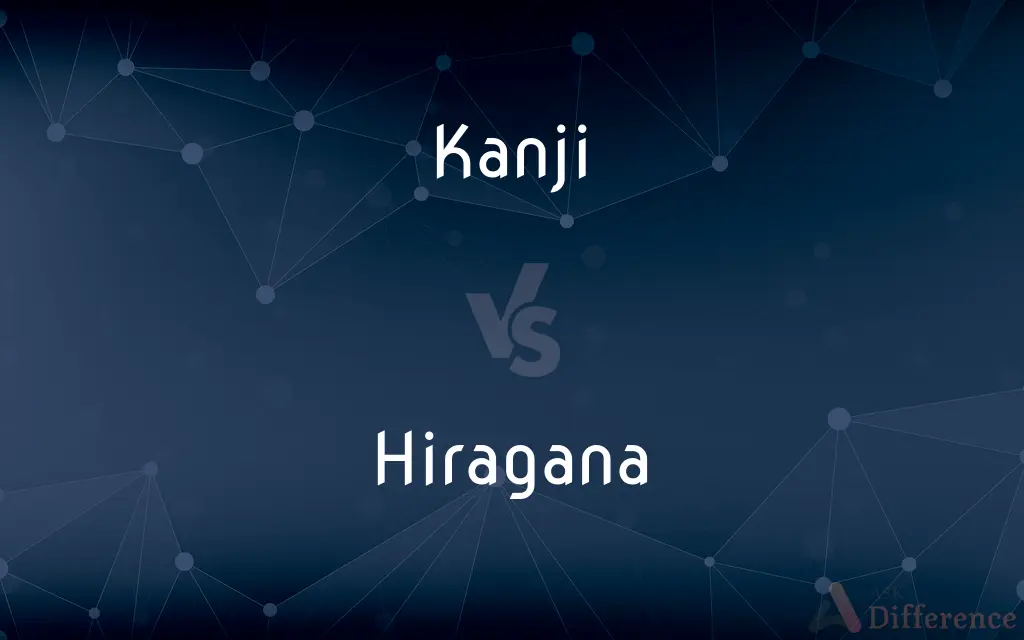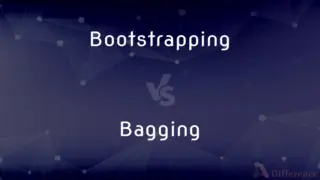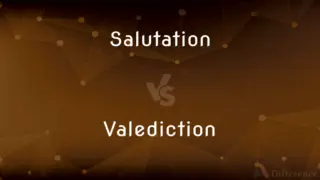Kanji vs. Hiragana — What's the Difference?
By Urooj Arif & Fiza Rafique — Updated on April 15, 2024
Kanji, derived from Chinese characters, conveys complex meanings and sounds, while Hiragana is a phonetic script used for native Japanese words and grammatical elements.

Difference Between Kanji and Hiragana
Table of Contents
ADVERTISEMENT
Key Differences
Kanji characters often represent both meaning and sound, enabling the expression of complex concepts with a single character. On the other hand, Hiragana is used for simpler, phonetic representations of sounds and plays a crucial role in the Japanese writing system for grammatical functions, such as conjugating verbs and adjectives.
While Kanji can be used to write whole words or concepts, Hiragana is typically used to write inflectional endings and function words that cannot be expressed in Kanji. This makes Hiragana indispensable for proper sentence structure in Japanese.
Kanji originated from Chinese characters and was adapted into the Japanese writing system, providing a deep layer of historical and cultural meaning. Hiragana, however, was developed locally in Japan, derived from simplified Chinese characters, to create a more accessible and flexible script.
Learning Kanji is known for being challenging due to the need to memorize thousands of characters and their multiple readings. Conversely, Hiragana consists of only 46 basic characters, making it much easier to learn and use effectively.
In practical usage, Kanji is often mixed with Hiragana in a sentence; Kanji represents the stems of words conveying key meanings, while Hiragana is used for grammatical structure. This combination allows for a nuanced and efficient communication style in written Japanese.
ADVERTISEMENT
Comparison Chart
Origin
Adapted from Chinese characters
Developed from Chinese characters
Function
Represents meanings and sounds
Represents only sounds
Use
Whole words or concepts
Grammatical elements, inflectional endings
Learning Complexity
High (thousands of characters)
Low (46 basic characters)
Cultural Significance
Deep historical roots
Modern simplification for ease of use
Compare with Definitions
Kanji
Used to represent nouns, stems of adjectives and verbs.
食べる (taberu) uses the Kanji 食 for eat.
Hiragana
A phonetic script used in Japanese writing.
あいうえお are the vowels in Hiragana.
Kanji
A system of Japanese writing using Chinese characters.
学校 (gakkou) means school in Kanji.
Hiragana
Characters are simpler and curvier than Kanji.
ねこ (neko) means cat in Hiragana.
Kanji
Each character has a unique meaning and pronunciation.
川 means river and is pronounced as kawa.
Hiragana
Used for grammatical particles and inflections.
が (ga) is a particle used in sentences.
Kanji
Characters that can have multiple readings.
時 can be read as ji (time) or toki (hour).
Hiragana
Essential for writing Japanese conjugations.
食べる (taberu) ends with る in Hiragana.
Kanji
Often used for names of places and people.
東京 (Tokyo) uses Kanji for east and capital.
Hiragana
Often used to write children’s literature.
かさ (kasa) means umbrella in Hiragana.
Kanji
Kanji (漢字, pronounced [kaɲdʑi] (listen)) are the adopted logographic Chinese characters that are used in the Japanese writing system. They are used alongside the Japanese syllabic scripts hiragana and katakana.
Hiragana
Hiragana (平仮名,ひらがな, Japanese pronunciation: [çiɾaɡaꜜna]) is a Japanese syllabary, one component of the Japanese writing system, along with katakana, kanji and in some cases Latin script. It is a phonetic lettering system.
Kanji
A Japanese system of writing based on borrowed or modified Chinese characters.
Hiragana
The cursive and flowing variety of kana used in most modern Japanese texts especially to represent inflectional endings and particles.
Kanji
A character used in this system of writing.
Hiragana
(uncountable) The main syllabary for the Japanese language, used to represent native Japanese words, including particles, and when kanji is used, to represent verb and adjective endings.
Kanji
(uncountable) The system of writing Japanese using Chinese characters.
Japanese is written in a mixture of kanji and kana.
Hiragana
A letter of this syllabary.
Kanji
Any individual Chinese character as used in the Japanese language.
I know about a thousand kanji.
Kanji
A North Indian fermented drink made with beetroot and carrots.
Common Curiosities
Can a sentence be written entirely in Hiragana?
Yes, it's possible, but uncommon for complex texts; Hiragana is usually mixed with Kanji for clarity and efficiency.
Is Hiragana easier to learn than Kanji?
Yes, Hiragana, with its 46 basic characters, is significantly easier to learn compared to the thousands of Kanji characters.
How many Kanji should a fluent Japanese speaker know?
A fluent speaker typically knows about 2,000 to 3,000 Kanji characters.
What is Kanji primarily used for in Japanese?
Kanji is used to write nouns, adjectives, verb stems, and conveying complex concepts and cultural meanings.
Do Hiragana characters have different meanings like Kanji?
Unlike Kanji, Hiragana characters do not have inherent meanings and are purely phonetic, used to represent sounds in the Japanese language.
What is the main purpose of Hiragana in the Japanese writing system?
Hiragana is mainly used for grammatical purposes, such as particles, verb and adjective conjugations.
Are there any digital tools that help with learning Kanji and Hiragana?
Numerous apps and software tools are available that help learners practice and memorize Kanji and Hiragana through repetitive drills, mnemonics, and quizzes.
How does the complexity of Kanji affect reading speed in Japanese?
Kanji's complexity can slow down reading speed for learners, but for native speakers, recognizable patterns and meanings can actually speed up reading as each Kanji conveys more information than a single Hiragana character.
Can Kanji characters change their pronunciation in different contexts?
Yes, many Kanji characters have multiple pronunciations or readings, which can change depending on the context or when combined with other characters.
How are Kanji integrated into daily Japanese writing?
Kanji are used daily in all types of writing in Japan, from official documents to casual texts, often mixed with Hiragana and Katakana to provide clarity and context.
Why is it important to know both Kanji and Hiragana in Japanese?
Knowing both scripts is essential for fluency in Japanese, as Kanji and Hiragana are used together to form sentences, with Kanji conveying the main content and Hiragana providing the grammatical structure.
How is Hiragana used in conjunction with foreign words?
Hiragana is not typically used for foreign words; instead, Katakana is used. Hiragana remains reserved for Japanese words and grammatical functions.
What role does Hiragana play in Japanese literature?
Hiragana is extensively used in Japanese literature, especially for native Japanese words, dialogue, and poetic writing where a softer, more traditional script is preferred.
What are some challenges foreigners face when learning Kanji and Hiragana?
Foreigners often struggle with memorizing the numerous characters and their multiple readings in Kanji, and adjusting to the phonetic simplicity but structural importance of Hiragana in constructing sentences.
Is there a standard order in which to learn Kanji and Hiragana?
Typically, learners start with Hiragana due to its simplicity and foundational role in the language, then progress to Kanji as their understanding of Japanese deepens.
Share Your Discovery

Previous Comparison
Bootstrapping vs. Bagging
Next Comparison
Salutation vs. ValedictionAuthor Spotlight
Written by
Urooj ArifUrooj is a skilled content writer at Ask Difference, known for her exceptional ability to simplify complex topics into engaging and informative content. With a passion for research and a flair for clear, concise writing, she consistently delivers articles that resonate with our diverse audience.
Co-written by
Fiza RafiqueFiza Rafique is a skilled content writer at AskDifference.com, where she meticulously refines and enhances written pieces. Drawing from her vast editorial expertise, Fiza ensures clarity, accuracy, and precision in every article. Passionate about language, she continually seeks to elevate the quality of content for readers worldwide.
















































